Oil tanker
[4][5] Second only to pipelines in terms of efficiency,[5] the average cost of transport of crude oil by tanker amounts to only US$5 to $8 per cubic metre ($0.02 to $0.03 per US gallon).Combination ore-bulk-oil carriers and permanently moored floating storage units are two other variations on the standard oil tanker design.Although human use of oil reaches to prehistory, the first modern commercial exploitation dates back to James Young's manufacture of paraffin in 1850.The expense was significant: for example, in the early years of the Russian oil industry, barrels accounted for half the cost of petroleum production.[11] These were followed in 1873 by the first oil-tank steamer, Vaderland (Fatherland), which was built by Palmers Shipbuilding and Iron Company for Belgian owners.[13] Other challenges included allowing for the cargo to expand and contract due to temperature changes, and providing a method to ventilate the tanks.[19] The idea that led to moving Russian oil to the Far East via the Suez Canal was the brainchild of two men: importer Marcus Samuel and shipowner/broker Fred Lane.[19] With facilities prepared in Jakarta, Singapore, Bangkok, Saigon, Hong Kong, Shanghai, and Kobe, the fledgling Shell company was ready to become Standard Oil's first challenger in the Asian market.[20] Forced to move oil around the Cape of Good Hope, shipowners realized that bigger tankers were the key to more efficient transport.In 1958 United States shipping magnate Daniel K. Ludwig broke the record of 100,000 long tons of heavy displacement.[27] The world's largest supertanker was built in 1979 at the Oppama shipyard by Sumitomo Heavy Industries, Ltd., named Seawise Giant.[38] In 1954, Shell Oil developed the "average freight rate assessment" (AFRA) system which classifies tankers of different sizes.[50] In a lump sum rate arrangement, a fixed price is negotiated for the delivery of a specified cargo, and the ship's owner/operator is responsible to pay for all port costs and other voyage expenses.Some particular variables include winter temperatures, excess tanker tonnage, supply fluctuations in the Persian Gulf, and interruptions in refinery services.[54] Owners of large oil tanker fleets include Teekay Corporation, A P Moller Maersk, DS Torm, Frontline, MOL Tankship Management, Overseas Shipholding Group, and Euronav.As of 2007, the United States Central Intelligence Agency statistics count 4,295 oil tankers of 1,000 long tons deadweight (DWT) or greater worldwide.[69] Six other flag states had more than 200 registered oil tankers: Liberia (464), Singapore (355), China (252), Russia (250), the Marshall Islands (234) and the Bahamas (209).[84] In 1998, the Marine Board of the National Academy of Sciences conducted a survey of industry experts regarding the pros and cons of double-hull design.Some of the advantages of the double-hull design that were mentioned include ease of ballasting in emergency situations,[85] reduced practice of saltwater ballasting in cargo tanks decreases corrosion,[86] increased environmental protection,[86] cargo discharge is quicker, more complete and easier,[86] tank washing is more efficient,[86] and better protection in low-impact collisions and grounding.[86] The same report lists the following as some drawbacks to the double-hull design, including higher build costs,[87] greater operating expenses (e.g. higher canal and port tariffs),[87] difficulties in ballast tank ventilation,[87] the fact that ballast tanks need continuous monitoring and maintenance,[87] increased transverse free surface,[87] the greater number of surfaces to maintain,[87] the risk of explosions in double-hull spaces if a vapor detection system not fitted,[88] and that cleaning ballast tanks is more difficult for double hull ships.[104] While pumping, tank levels are carefully watched and key locations, such as the connection at the cargo manifold and the ship's pumproom are constantly monitored.Specially trained personnel monitor the tank's atmosphere, often using hand-held gas indicators which measure the percentage of hydrocarbons present.[107] Mucking requires protocols for entry into confined spaces, protective clothing, designated safety observers, and possibly the use of airline respirators.This process, called underway replenishment, extends the length of time a naval vessel can stay at sea, as well as her effective range.[113] In practice, the flexibility which the OBO design allows has gone largely unused, as these ships tend to specialize in either the liquid or dry bulk trade.[112] On one hand, due to a less specialized design, an OBO suffers more from wear and tear during dry cargo onload than a bulker.[112] On the other hand, components of the liquid cargo system, from pumps to valves to piping, tend to develop problems when subjected to periods of disuse.Crude oil contains polycyclic aromatic hydrocarbons (PAHs) which are very difficult to clean up, and last for years in the sediment and marine environment.[116] Marine species constantly exposed to PAHs can exhibit developmental problems, susceptibility to disease, and abnormal reproductive cycles.[118] On the other hand, spills resulting from accidents like collisions, groundings, hull failures, and explosions are much larger, with 84% of these involving losses of over 700 metric tons.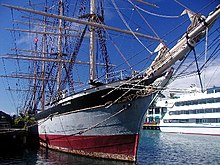
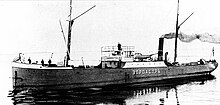



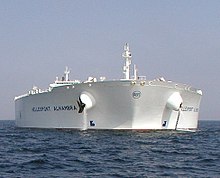
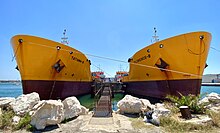
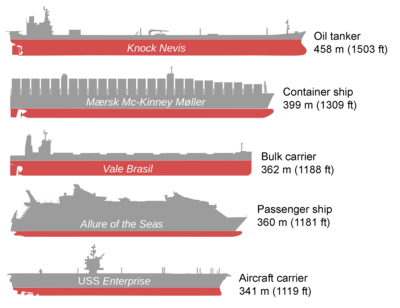
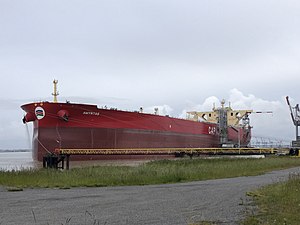




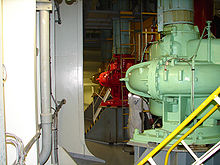




aerial firefighting747 SupertankerHandysizePanamaxAframaxSuezmaxTank shipbulk transportcrude oilrefineriesdeadweightbillionmetric tonsshort tonspipelinesreplenishment oilerfuel a moving vesselore-bulk-oil carriersfloating storage unitsoil spillsHistory of the oil tankerFalls of ClydeJames YoungPennsylvania oil fieldsEdwin DrakeTitusville, PennsylvaniaBreak-bulkRiver TynePalmers Shipbuilding and Iron CompanyLudvigRobert NobelAlfred NobelBranobelAzerbaijanoil companiesMotala Verkstadlong tonsbuoyancySwedenCaspianBaltic SeaLake LadogaLake OnegaRybinskMariinsk CanalsVolga Riverfree surface effectGlückaufFire Islandcofferdamsballast tankStandard Oil Companysister shipsgroundedRoyal Dutch PetroleumDutch East IndiesIndonesiaSuez CanalMarcus SamuelSuez Canal CompanyWilliam Gray & CompanyRoyal Dutch ShellJakartaSingaporeBangkokSaigonHong KongShanghaiSuez CrisisCape of Good HopeT2 tankerMiddle Eastoil refineriesVickers Armstrongs Shipbuilders LtdEnglandStavros NiarchosDaniel K. LudwigBarrow-in-FurnessElizabeth IIKnock NevisOppamaSumitomo Heavy Industries, Ltd.Seawise Giantlength overallEnglish ChannelscrappedTI-class supertankersOverseas Shipholding GroupEuronavgallonProduct tankerTI-class supertankerShell OilNew York Mercantile Exchangefuturessingle-point mooringslighteringChartering (shipping)charter partybareboat chartercontract of affreightmentfreight rateWorldscalePersian GulfTeekay CorporationA P Moller MaerskDS TormFrontlineMOL Tankship ManagementNational Shipping Company of Saudi ArabiaTanker Pacific ManagementNippon Yusen KaishaMISC BerhadVela International MarineHyundai Merchant MarineBW ShippingMaersk TankersBP ShippingSovcomflotNovorossiysk Shipping CompanyShipping Corporation of IndiaChevron ShippingCOSCO GroupKuwait Oil Tanker Co.China Shipping Development TankerSK Shipping